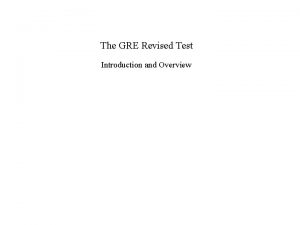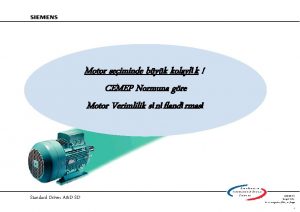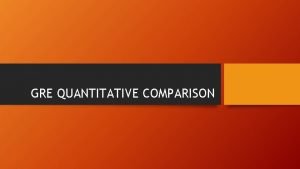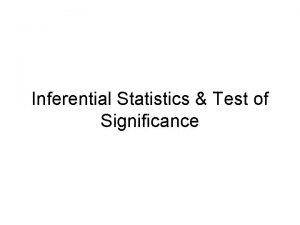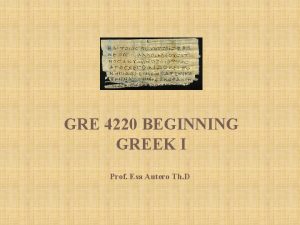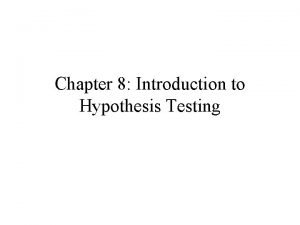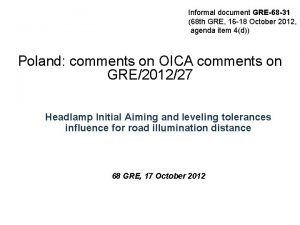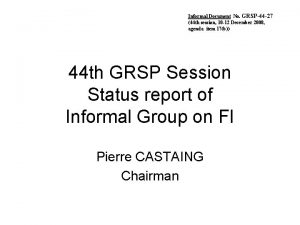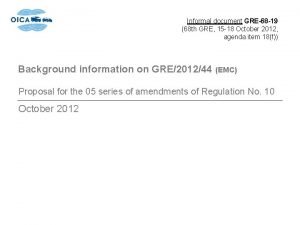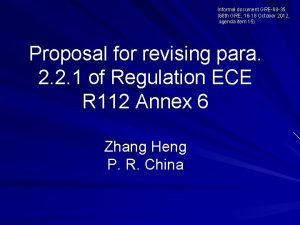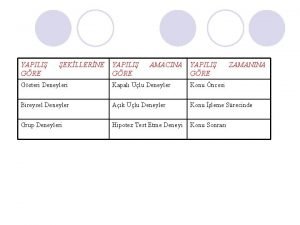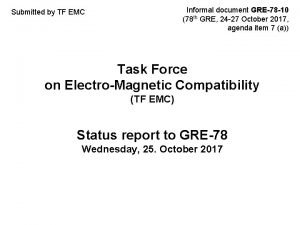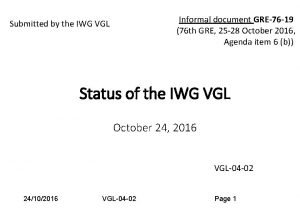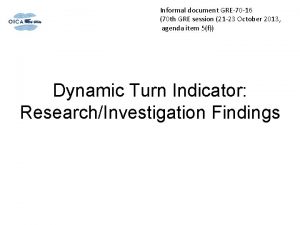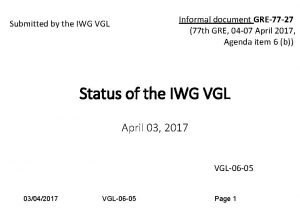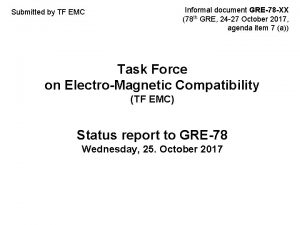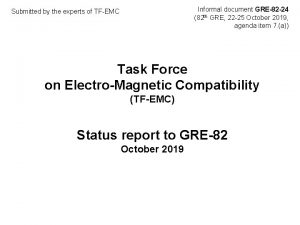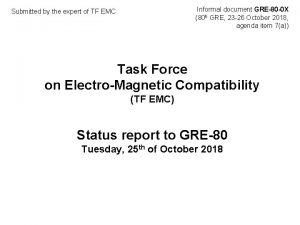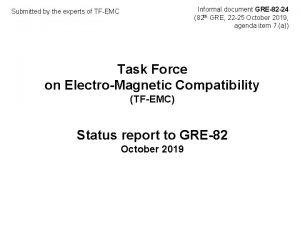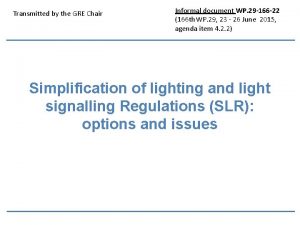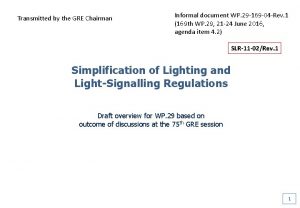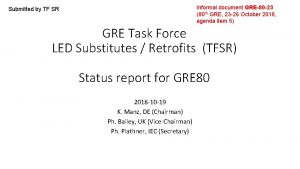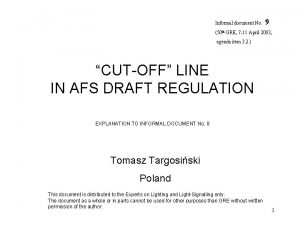Informal document GRE68 31 68 th GRE 16























- Slides: 23

Informal document GRE-68 -31 (68 th GRE, 16 -18 October 2012, agenda item 4(d)) Poland: comments on OICA comments on GRE/2012/27 Headlamp Initial Aiming and leveling tolerances influence for road illumination distance 68 GRE, 17 October 2012 THE SOCIETY OF MOTOR MANUFACTURERS AND TRADERS LIMITED PAGE 1

GRE/2012/27 proposes changes to ECE R 48 to improve the minimum range of visibility, and to replace the artificial 2000 lm limit for automatic levelling with more appropriate glare control. Road illumination distance understand as cut-off crossing with road surface – clear and simple definition in line with present Reg. 112, 98, 123 and aiming practice THE SOCIETY OF MOTOR MANUFACTURERS AND TRADERS LIMITED PAGE 2

Proposed changes: • To redefine the initial aim and static load-levelling requirements of dip beam cut-off in terms of theoretical range on the road rather than the current % downward inclination. How is „practical” range guaranteed by present ECE Regulations or by manufactures? Do drivers know it ? • To reduce aiming tolerance, and delete the additional aiming tolerance in Co. P, aligning it with the approval requirement. • To add a requirement to measure glare values in loaded conditions as part of both Type Approval and Co. P, if the resultant aim falls outside permitted tolerance. Glare is restricted and controlled by headlamp Regulations (112, 98, 123). Till now it is no any reference on vehicle to this defined glare values. According to present requirements of Reg. 48 “on vehicle” glare can differ from regulated in 112, 98 and 123 in uncontrolled manner. It should be clarified how much more glare is accepted and how to ensure it. Artificial 2000 lm borderline does not work. THE SOCIETY OF MOTOR MANUFACTURERS AND TRADERS LIMITED PAGE 3

Proposed changes: • To delete the reference to 2000 lm as a threshold for automatic levelling. Presently are the same restrictions for manual and automatic levelling ( 2%-2. 5%) but practice for automatic levelling is diverse. • To add a visible warning to the driver, defining what is the minimum visibility distance, if theoretical range is less than 50 m. „Road illumination distance” THE SOCIETY OF MOTOR MANUFACTURERS AND TRADERS LIMITED PAGE 4

Proposed Initial nominal aim to correspond to 75 m theoretical range • Specified % inclination is ( Headlamp height / 75 ) as a %, rounded to nearest 0. 1%. THE SOCIETY OF MOTOR MANUFACTURERS AND TRADERS LIMITED PAGE 5

Proposed Initial nominal aim to correspond to 75 m theoretical range • Currently: initial aim is specified by the manufacturer, within permitted limits dependent on lamp height. Height bands overlap for tolerance. min height max height %down 500 1000 1. 0% to 1. 5% 800 1200 1. 5% to 2. 0% THE SOCIETY OF MOTOR MANUFACTURERS AND TRADERS LIMITED PAGE 6

Proposed Initial nominal aim to correspond to 75 m theoretical range • Under proposal, What for are needed overlaps? • No overlap between height bands • Most headlamps would be aimed higher than at present It will depend on manufacturers decision and choice of range of amended Reg. 48 (30 to 100 m or 50 to 100 m) It will be safety oriented advantage and goal of amendment because of longer average road illumination distance. • Risks increased glare. Not true. Decreased glare comparing present state. THE SOCIETY OF MOTOR MANUFACTURERS AND TRADERS LIMITED PAGE 7

Proposed Initial nominal aim to correspond to 75 m theoretical range <sports car < normal family car < van/SUV Is it any reference in Reg. 48 to sports car, normal family car, van/SUV? Should be introduced? Why? THE SOCIETY OF MOTOR MANUFACTURERS AND TRADERS LIMITED PAGE 8

Theoretical Range vs. real visibility • Is Theoretical Range a good measure of real visibility range? : • CIE TC 4 -45 generated a way to measure visibility range: it is significantly more complicated than simply the cut-off intersection, but correlates well with human perception. • The following examples are taken from the CIE TC 4 -45 report • Two similar R 98 headlamps, with similar mounting heights (715 mm, 717 mm) • Both are aimed at 1. 0% down. This is the same value of aim that would apply under the proposal for these headlamp heights. • Ranges are calculated according to TC 4 -45 method. THE SOCIETY OF MOTOR MANUFACTURERS AND TRADERS LIMITED PAGE 9

60 m Glare intensities plotted on screen located at 50 m from Car forward Visibility 75 m Low gradient through the cutoff = less glare sensitivity to initial aiming tolerances Illuminance values plotted on screen at 25 m (0, 0 is the Headlamp Optical Axis) Illuminance values plotted on road surface

85 m Glare intensities plotted on screen located at 50 m from Car forward Visibility 75 m High gradient through the cutoff = more glare sensitivity to initial aiming tolerances Illuminance values plotted on screen at 25 m (0, 0 is the Headlamp Optical Axis) Illuminance values plotted on road surface

Theoretical Range vs. real visibility • Both lamps have a theoretical range of 75 m • Sample 11 has TC 4 -45 visibility range of 60 m • Sample 5 has TC 4 -45 visibility range of 85 m • Conclusion: theoretical range is a poor measure of real-world visibility THE SOCIETY OF MOTOR MANUFACTURERS AND TRADERS LIMITED PAGE 12

Theoretical Range vs. real visibility • Conclusion: theoretical range is a poor measure of real -world visibility To objectively assess aiming/leveling results of GRE/2012/27 appropriate are calculations for lowest allowed leveling according present requirements 2. 5% down aiming. How big will be differences between both headlamps and where will be 3 lx position on left side? Have in mind inverted square law. 1% aiming is inappropriate for this situation. By 2. 5% aiming results should be very closed to 28 m In GRE/2012/27 is proposed : ”It is also possible on the same way to declare a longer than minimum required road illumination distance according applicant knowledge” Could be modified „It is also possible on the same way to declare a longer or shorter than minimum required road illumination distance according applicant knowledge” THE SOCIETY OF MOTOR MANUFACTURERS AND TRADERS LIMITED PAGE 13

Tolerance with load levelling to be 50 m to 100 m theoretical range (6. 2. 6. 1. 2) for both approval and Co. P • Currently total load levelling tolerance is 2. 0% approval, 2. 6% Co. P • Manufacturer may define initial aim to optimise levelling results THE SOCIETY OF MOTOR MANUFACTURERS AND TRADERS LIMITED PAGE 14

Tolerance with load levelling to be 50 m to 100 m theoretical range (6. 2. 6. 1. 2) for both approval and Co. P • Proposal is shown expressed as %. • Initial aim is defined by regulation • Highest permitted aim with levelling unchanged at -0. 5% • Corresponds to a reduction in load levelling tolerance for most cars of 60 -75% It is alternative in GRE/2012/27: „The crossing distance could be lower but not less than [25 m or 30 m] under the condition that there will be information for driver It should be carefully verified. But. . . What is the problem? Manufacturers convenience (because not technical possibility) or. . . THE SOCIETY OF MOTOR MANUFACTURERS AND TRADERS LIMITED PAGE 15 SAFETY OF MILIONS DRIVERS AND PEDESTRIANS

Tolerance with load levelling Example for 650 mm high passenger car headlamp • To consistently meet Co. P requirements, initial aim and levelling system need to be repeatable with a standard deviation of better than 0. 1%. Repeatability of suspension system alone is not this good. THE SOCIETY OF MOTOR MANUFACTURERS AND TRADERS LIMITED PAGE 16

Tolerance with load levelling Example for 650 mm high passenger car headlamp • To consistently meet Co. P requirements, initial aim and levelling system need to be repeatable with a standard deviation of better than 0. 1%. Repeatability of suspension system alone is not this good. Repeatability (tested in Motor Transport Institute including performance of suspension) for automatic leveling for many cars was much better than 0. 1% For same (van/SUV/delivery trucks) tolerances are bigger For some cars (sport cars) THE SOCIETY OF MOTOR MANUFACTURERS AND TRADERS LIMITED are lower PAGE 17

6. 2. 6. 1. 3 requires that if, under loading conditions of Annex 5, aim falls above the 100 m range, glare must be measured • This is assessing the glare with the headlamp aimed as it would be under Annex 5 load conditions. Measurement to take place during headlamp type approval. • But at time of headlamp Type Approval, R 48 inspection has not taken place, so the aim of the headlamp under Annex 5 conditions is not known. At time of headlamp Type Approval, could be very easy measured and additionally reported: - what are the highest possible aiming/ mounting height values THE SOCIETY OF MOTOR MANUFACTURERS AND TRADERS LIMITED PAGE 18

Deletion of 2000 lm requirement Current regulation para 6. 2. 9 prohibits the use of para 6. 2. 2. 2 manual levelling option with LED or >2000 lm light sources • Proposal deletes this prohibition • Provided that 50 -100 m theoretical range can be achieved by manual levelling, manual levelling would be permissible for any headlamp. • GTB working group is currently reviewing visibility and glare: it would be better to await their outcome. GTB working group reviewed GLARE ONLY (Klettwitz tests) in respect to obligatory automatic leveling. Results are as was easy to theoretically predict: significant influence of pitch angle. No significant influence of light source flux. No visibility range research were done till now. It is easy to predict that cut-off position at 20 m before vehicle (or less for Co. P reasons) cannot guarantee visibility for speed of 100 km/h THE SOCIETY OF MOTOR MANUFACTURERS AND TRADERS LIMITED PAGE 19

Warning message • If theoretical range under Annex 5 loading conditions falls below 50 m but above 25 m, a warning notice is to be placed in the car, declaring the minimum theoretical range as a minimum ”visibility distance” • Visibility distance does not correlate directly with theoretical range (see above). For short distances correlates very well Please verify before reporting THE SOCIETY OF MOTOR MANUFACTURERS AND TRADERS LIMITED PAGE 20

GRE/2012/21 proposed changes to ECE R 48 (1 of 3): To redefine the initial aim and static load-levelling requirements of dip beam headlamps in terms of theoretical range on the road rather than the current % downward inclination. Conclusion: • Redefining the aim point will raise the aim for most passenger cars This may not give the desired visibility range • To prevent this causing increased glare, aiming and levelling tolerances must be tightened • Industry needs aiming and levelling capability data to identify if this tolerance tightening is practicable. THE SOCIETY OF MOTOR MANUFACTURERS AND TRADERS LIMITED PAGE 21

Conclusion: • Redefining the aim point will raise the aim for most passenger cars This may not give the desired visibility range Not proved. Illegitimate statement. • To prevent this causing increased glare, aiming and leveling tolerances must be tightened • Industry needs aiming and levelling capability data to identify if this tolerance tightening is practicable. It is not a problem to identify. It is possible esy measure values for vehicles offered on market. It is simple and it was done. THE SOCIETY OF MOTOR MANUFACTURERS AND TRADERS LIMITED PAGE 22

THANK YOU FOR YOUR ATTENTION
 Javascript:document.write(document.cookie)
Javascript:document.write(document.cookie) Gre
Gre Gre sınav soruları
Gre sınav soruları Iz zemlje gre v trto
Iz zemlje gre v trto Motor gre
Motor gre Gre quantitative comparison
Gre quantitative comparison Difference of t distribution and normal distribution
Difference of t distribution and normal distribution Maria gre
Maria gre Gre syllabus
Gre syllabus Iprof gre
Iprof gre Gre bakery
Gre bakery Gre test
Gre test Peter gre
Peter gre Gre recife sul
Gre recife sul Kaplan gre
Kaplan gre Gre elaboration
Gre elaboration Pronounce postgre
Pronounce postgre Cem yurtsev
Cem yurtsev Gre benefits
Gre benefits The power of film video and tv in the classroom
The power of film video and tv in the classroom Gre
Gre Informal document
Informal document Registro inculto informal ejemplos
Registro inculto informal ejemplos Mhc document express support
Mhc document express support

